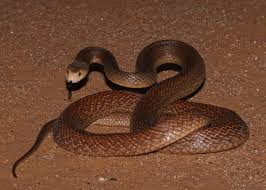Taipans (Oxyuranus scutellatus) had a fearsome reputation when I was growing up in North Queensland.
I had a close encounter with one on our school's pineapple project garden when I about eight. I was weeding pineapple plants with a hoe, and blundered across a large and healthy specimen curled up against the row.
I'm not sure who got the biggest fright, the taipan or me, but it uncurled itself in a flash and began to chase me along the row. They move very quickly.
I threw the hoe at it which distracted it somewhat, and took giant steps, not looking back until the pineapple patch was more than 100 metres behind. I reckon I was hovering most of the way.
The snake had disappeared by the time my father, responding to my pale face and eyes like saucers, turned up with his dilapidated shotgun.
The only time we ever saw the shotgun was when snakes were about, but there are still holes in the roof of the school toilet where dad dispatched a snake with it in the 50s. I know this because I went back to the school years ago, and found them - the holes, not the snakes.
This was sugar cane country, and there were snakes of all kinds in the area.
We used to get regular visits from a snake expert called Ram Chandra, an Indian chap who made a reasonable living out of touring schools with boxes of snakes and giving informative talks about reptiles. He was one of a group of pioneers who helped develop an antivenene.
Years later, when I was teaching kids with disabilities in Townsville, we were taking a group of these children on a bush walk in coastal scrub not far from the CBD. One of the boys, a lad with Down Syndrome kept lagging behind, and I had, on a few occasions, to leave the main group and check to see if he was OK.
Towards the end of the hike, when everyone was getting a bit tired, he was behind again, so I called his name. His response as I heard it, was "Taipan, taipan!".
I ran back at about the same pace I had used when chased by a taipan as a kid, frantically trying to recall the first aid techniques for managing snakebite that I'd learnt to keep my St John's certificate current.
When I reached him, he was sitting on the track, looking a bit flustered, but showing no symptoms of snakebite.
It turned out that what he was actually saying was "Tight pants", not 'taipan".
The pants were what was slowing him down.
In hindsight, it's funny, but at the time I was far from amused...
Comments closed.




